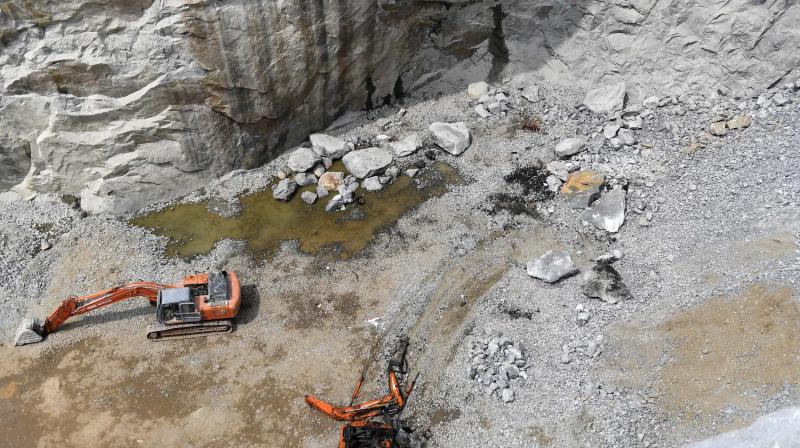Thiruvananthapuram: Granite mount crushes two, injures six

THIRUVANANTHAPURAM: Two workers were killed and six others injured after a portion of granite mount inside a quarry came crashing down on them at Kunnathukal near Parassala around 30 kilometres from capital city on Friday. The deceased were identified as Satheesh, 29, of Salem and Binilkumar, 23, of Maalakulangara near Marayamuttom in Thiruvananthapuram. Two injured, identified as Sudhin, 23, and Aji, 45, were admitted to Thiruvananthapuram Medical College Hospital with serious leg injuries. Aji’s left leg was amputated. The others admitted to Marayamuttom taluk hospital were identified as Bijil, Jose, Selvaraj and Rajendran.
As per Marayamuttom police, the incident happened at the quarry owned by one Alosyious at around 10.30 am. The workers have been cutting out the bottom of a granite mount leaving out a huge portion uncrushed at top during the past days. On Friday, minutes after they began the work using a breaker and heavy excavator, the mount caved in. Satheesh, the excavator operator was killed immediately and the heavy machinery was decimated.
Others were trapped in rubbles and all of them were rescued by workers and local people. They were rushed to hospitals in a tipper lorry. Binilkumar was declared dead upon arrival at Medical College Hospital. Satheesh's body is kept at Neyyatinkara General Hospital. Both were bachelors and the body will be handed over to relatives after autopsy. Local MLA C.K. Hareendran told media that the quarry did not have license to function from panchayat since 2016. The owner was engaged in a legal battle to have the ban lifted. He was booked under IPC section 304 for culpable homicide not amounting to murder.
Quarry functioned sans license
Like many quarries in the area, the disaster struck quarry at Kunnathukal, located on Shasthampara range had no license from local panchayat. Several quarries in the surrounding areas of Kunnathukal, Anavoor, Vellarada and Kottakkal also function illegally. As per Shasthampara Protection Council (SPC) members, the quarry owners flaunt the single window permissions issued by Mining and Geology Department. The police had sent a complaint to the higher officials against the disaster struck quarry owned by one Alosyious last year also.
The said quarry land sits close to purambokku land.
"As per norms, only small scale blasting of rock by filling explosives in 2.5 feet depth is allowed. However in most quarries blasting is conducted with explosives filled in depths of 20-25 feet. The resulting blast can be heard for kilometres," says an SPC activist. Adding to the woes of immediate neighbours, the buffer zone for quarrying activities was being reduced every now and them. The legal tussle to save Shasthmpara gained momentum in 2014-15. The activists and local residents cited dip in ground water level, pollution among others to challenge the mining.
A stop memo was issued to quarries but was later revoked after a High Court verdict went in favour of quarry owners. Then came the recent NGT verdict which ordered shutdown of the quarry. "The Shasthampara range had several purampokku lands few years back. Over past three decades many of them were handed over to private parties who pay tax and secure title deeds," the activist pointed. Meanwhile, a big section of local residents says they support quarrying due to the monetary benefits and employment they provide. Not less than 150 families were being supported by the disaster struck quarry.
Need steps to curb illegal quarrying
The lack of a proper mechanism to monitor the quarries in the state has led to a situation where even quarries that do not possess a valid explosive licence operate with impunity. None of the supervisory bodies – Pollution Control Board, State Environment Impact Assessment Authority (SEIAA) and the Department of Mining and Geology (DMG) – have a system for periodical monitoring. What’s more, the State Government has done nothing to identify the areas that had become sensitive as a result of excessive exploitation or where quarrying posed a threat to the environment. As per Kerala Minor Mineral Concession Rules, 2015, quarry operators, before starting operations, are required to obtain consent from the PCB, secure an environment clearance from the SEIAA and a quarrying permit from the DMG.
Problem is, these bodies fail to do the follow up. They have neither the system nor the manpower for such an exercise. The state government has issued a circular in March 2014 stating that the authority empowered to give sanction should also ensure that there is no violation of conditions. This requires physical verification by the agencies concerned. While issuing consent to operate, the PCB will impose certain conditions to the quarry operators based on Water (Prevention and Control of Pollution) Act, 1974, Air (Prevention and Control of Pollution) Act, 1981 and Environment Protection Act, 1986. However, both the PCB and SEIAA are handicapped by staff shortage. “With the kind of staff strength we have it is impossible to keep track of all the innumerable clearances that we had given across the state,” a top SEIAA official said.
Even a government department like DMG has no systems to monitor the adherence to Kerala Minor Minerals Cocession Rules. The latest report of the Comptroller and AuditorGeneral, too, has confirmed that the DMG does not conduct periodical inspection of quarry sites to monitor implementation of KMMC Rules. The DMG issues quarrying permits and leases and the permit or lease holders have to satisfy conditions specified in the permits. The lease violations include non-observance of safety measures, operation after expiry of permit, operating without explosive licence, and non-demarcation of quarry area.

